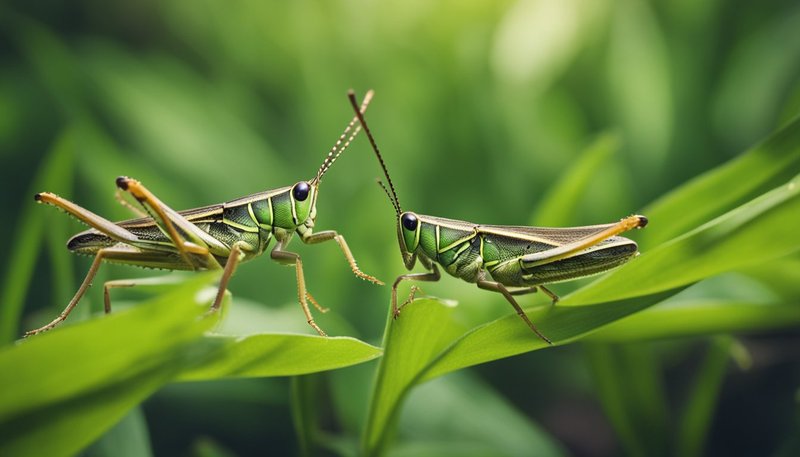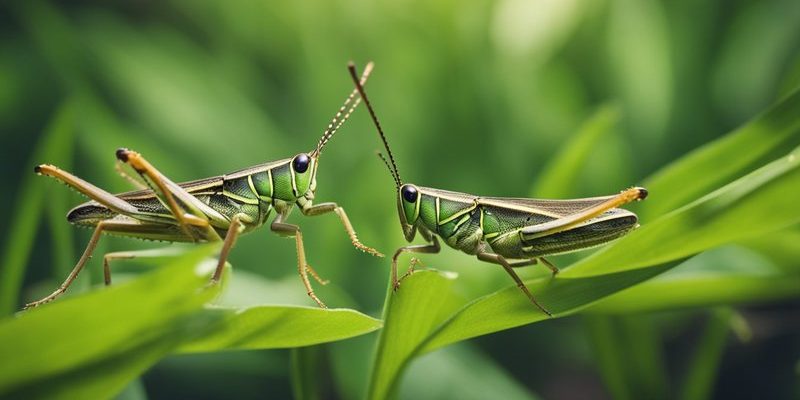
Think of grasshoppers as nature’s busy workers. They’re not just hopping around aimlessly; they’re performing important tasks that help keep ecosystems balanced. Like tiny chefs mixing ingredients in a recipe, grasshoppers contribute to the health of their habitats in various ways. And if you’ve ever wondered about their specific contributions, you’re in just the right place!
Grasshoppers: The Herbivores of the Insect World
Grasshoppers are primarily herbivores, which means they mainly eat plants. Their diet mostly consists of grasses and leaves, which they chew up using their powerful mandibles. This feeding behavior has a ripple effect on the environment.
When grasshoppers eat plants, they help control the growth of vegetation. By munching on young leaves or stems, they prevent any one plant species from dominating the landscape. This *plant diversity* is crucial because it allows various other species—insects, birds, and mammals—to thrive as well.
Imagine a garden filled with a single plant species. It might look nice at first, but over time, it could become a barren wasteland for other living creatures. Grasshoppers help keep these gardens healthy and diverse, which is essential for the stability of ecosystems.
Grasshoppers as a Food Source
One of the most critical roles grasshoppers play in ecosystems is serving as a food source for other animals. Birds, frogs, and even some larger insects rely on grasshoppers for nourishment.
This is where the food web comes into play. Grasshoppers sit near the bottom of this web, providing energy for those higher up. For instance, a hawk might catch a grasshopper for lunch, transferring the energy it gained from the plants to itself and then to whatever eats the hawk.
Their presence enriches the biodiversity of an area, supporting a wide range of predators. Without grasshoppers, many of these animals might struggle to find enough food, which could affect their populations and the ecosystems they inhabit.
Grasshoppers and Soil Health
You might not think about soil when you see grasshoppers jumping around, but they significantly impact soil health as well. When grasshoppers eat plants, they often leave behind nutritious droppings, known as *frass*. This frass is packed with nutrients like nitrogen, phosphorus, and potassium, which are essential for plant growth.
Moreover, the work they do while hopping and feeding can help aerate the soil. This aeration allows rainwater to soak in better and helps roots access the air they need to thrive. Healthy soil is key to supporting plant life, which in turn supports the entire ecosystem.
Think of grasshoppers as tiny gardeners, working hard to enrich the earth beneath us. Their droppings not only provide food for plants but also create a healthier environment for other organisms that contribute to soil quality.
Grasshoppers and Seed Dispersal
Another often-overlooked role of grasshoppers is their involvement in seed dispersal. While they primarily feed on leaves and stems, some species will snack on seeds. When grasshoppers digest these seeds and then drop them elsewhere—whether through frass or just as they hop around—they help plants spread and grow in new areas.
This spreading of seeds is fundamental for maintaining plant diversity across different regions. It allows new plants to grow in areas where they might not have been able to thrive otherwise.
Furthermore, this process is essential for some specific plant species that rely on animals to disperse their seeds. It’s like a little delivery service, ensuring that plants can expand their territories and find new homes.
The Impact of Grasshopper Populations
Like any creature in the ecosystem, grasshopper populations can fluctuate. When their numbers grow too high, they can become pests, damaging crops and native plants. This is where things can get tricky. While they have many beneficial roles, overpopulation can lead to destruction.
Farmers and land managers often need to monitor grasshopper populations to prevent excessive damage to crops. It’s a delicate balance—ensuring that grasshoppers can continue doing their important work while also protecting food sources for humans and other wildlife.
Interestingly, drought conditions can lead to population booms, as grasshoppers tend to thrive in dry environments. This can create a cycle of boom and bust as grasshoppers overconsume their resources, depleting the vegetation and leading to a die-off.
Grasshoppers and Climate Change
Grasshoppers, like many other insects, are indicators of environmental health. Changes in their populations can signal shifts in climate or habitat conditions. For example, if grasshoppers start to die off, it might mean that something is wrong in their ecosystem—possibly due to pollution, habitat loss, or climate change.
As temperatures rise, grasshoppers are likely to adapt their habits and range, which can affect local ecosystems. This adaptability is a double-edged sword; while it allows them to survive, it can also lead to new challenges for the plants and animals that share their habitat.
Monitoring grasshopper populations can provide crucial data to ecologists studying the effects of climate change. By understanding how these insects react to changing environments, scientists can gain insights into broader ecological shifts.
Grasshoppers might seem small and inconspicuous, but their roles in ecosystems are nothing short of vital. From helping maintain plant diversity to serving as key food sources and contributing to soil health, these little creatures are true unsung heroes of the natural world.
In a constantly changing environment, understanding the significance of grasshoppers can help us appreciate the interconnectedness of life. So, next time you hear their cheerful buzz on a sunny day, remember that they’re doing more than just adding a soundtrack to your summer—they’re playing essential roles in our ecosystems, keeping the balance of life in check.

